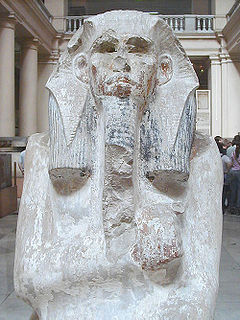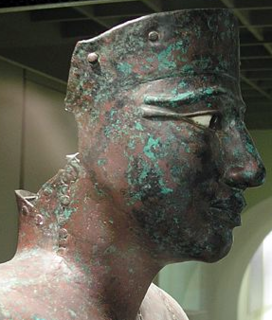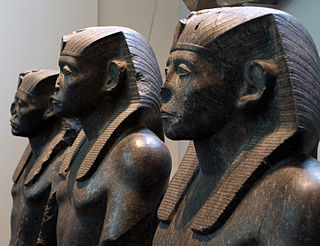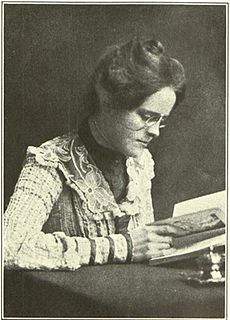Related Research Articles

Djoser was an ancient Egyptian pharaoh of the 3rd Dynasty during the Old Kingdom and the founder of this epoch. He is also known by his Hellenized names Tosorthros and Sesorthos. He was the son of king Khasekhemwy and queen Nimaathap, but whether he also was the direct throne successor is still unclear. Most Ramesside Kinglists name a king Nebka before him, but since there are still difficulties in connecting that name with contemporary Horus names, some Egyptologists question the received throne sequence.

Khufu was an ancient Egyptian monarch who was the second pharaoh of the Fourth Dynasty, in the first half of the Old Kingdom period. Khufu succeeded his father Sneferu as king. He is generally accepted as having commissioned the Great Pyramid of Giza, one of the Seven Wonders of the Ancient World, but many other aspects of his reign are poorly documented.

The Middle Kingdom of Egypt is the period in the history of ancient Egypt following a period of political division known as the First Intermediate Period. The Middle Kingdom lasted from approximately 2040 to 1782 BCE, stretching from the reunification of Egypt under the reign of Mentuhotep II in the Eleventh Dynasty to the end of the Twelfth Dynasty. The kings of the Eleventh Dynasty ruled from Thebes and the kings of the Twelfth Dynasty ruled from el-Lisht.

The Autobiography of Weni is a tomb inscription from ancient Egypt, which is significant to Egyptology studies. Weni the Elder, or Uni, was a court official of the 6th Dynasty of Ancient Egypt.

The Twelfth Dynasty of ancient Egypt is considered to be the apex of the Middle Kingdom by Egyptologists. It often is combined with the Eleventh, Thirteenth, and Fourteenth dynasties under the group title, Middle Kingdom.

Pepi I Meryre was an Ancient Egyptian pharaoh, third king of the Sixth Dynasty of Egypt, who ruled for over 40 years at the turn of the 24th and 23rd centuries BC, toward the end of the Old Kingdom period. He was the son of Teti, the founder of the dynasty and ascended the throne only after the brief intervening reign of the shadowy Userkare. His mother was Iput, who may have been a daughter of Unas, the final ruler of the preceding Fifth Dynasty. Pepi I, who had at least six consorts, was succeeded by his son Merenre Nemtyemsaf I, with whom he may have shared power in a coregency at the very end of his reign. Pepi II Neferkare, who might also have been Pepi I's son, succeeded Merenre.

Djedkare Isesi was a pharaoh, the eighth and penultimate ruler of the Fifth Dynasty of Egypt in the late 25th century to mid-24th century BC, during the Old Kingdom. Djedkare succeeded Menkauhor Kaiu and was in turn succeeded by Unas. His relations to both of these pharaohs remain uncertain, although it is often conjectured that Unas was Djedkare's son, owing to the smooth transition between the two.

Khakaure Senusret III was a pharaoh of Egypt. He ruled from 1878 BC to 1839 BC during a time of great power and prosperity, and was the fifth king of the Twelfth Dynasty of the Middle Kingdom. He was a great pharaoh of the Twelfth Dynasty and is considered to be, perhaps, the most powerful Egyptian ruler of the dynasty. Consequently, he is regarded as one of the sources for the legend about Sesostris. His military campaigns gave rise to an era of peace and economic prosperity that reduced the power of regional rulers and led to a revival in craftwork, trade, and urban development. Senusret III was among the few Egyptian kings who were deified and honored with a cult during their own lifetime.

Shunet El Zebib, alternatively named Shuneh and Middle Fort, is a large mudbrick structure located at Abydos in Upper Egypt. The edifice dates to the Second Dynasty, and was built by the ancient Egyptian king (pharaoh) Khasekhemwy.

Khasekhemre Neferhotep I was an Egyptian pharaoh of the mid Thirteenth Dynasty ruling in the second half of the 18th century BC during a time referred to as the late Middle Kingdom or early Second Intermediate Period, depending on the scholar. One of the best attested rulers of the 13th Dynasty, Neferhotep I reigned for 11 years.
David Bourke O’Connor is a retired Australian-American Egyptologist who primarily worked in the fields of Ancient Egypt and Nubia. O’Connor is the Lila Acheson Wallace Professor Emeritus at New York University’s Institute of Fine Art, the Curator Emeritus of the University of Pennsylvania’s Egyptian Museum, and the Director Emeritus at the Abydos Archaeology expedition in Egypt. O’Connor is most well-known for his work in the excavation of the ancient city of Abydos in Egypt since 1967.

Barbara Georgina Adams, FRSA was a distinguished British Egyptologist and specialist in predynastic history. She worked for many years at Hierakonpolis, where she was the co-director of the expedition. Before this she worked at the Petrie Museum of Egyptian Archaeology in London and worked on excavations across Britain.
Josef William Wegner is an American Egyptologist, archaeologist and associate professor in Egyptology at the department of near eastern languages and civilizations of the University of Pennsylvania, where he obtained his Ph.D. degree in Egyptology. His father is the astrophysicist, Gary A. Wegner.
David Randall-MacIver FBA was a British-born archaeologist, who later became an American citizen. He is most famous for his excavations at Great Zimbabwe which provided the first solid evidence that the site was built by Shona peoples.
William Kelly Simpson was an American professor of Egyptology, Archaeology, Ancient Egyptian literature, and Afro-Asiatic languages at Yale University.

Henri Édouard Naville was a Swiss archaeologist, Egyptologist and Biblical scholar.
Colleen Darnell is an American Egyptologist. Her areas of expertise include Late Period uses of the Underworld Books, ancient Egyptian military history, the literature of New Kingdom Egypt, and Egyptian revival history.

Caroline Ransom Williams was an Egyptologist and classical archaeologist. She was the first American woman to be professionally trained as an Egyptologist. She worked extensively with the Metropolitan Museum of Art (MMA) in New York and other major institutions with Egyptian collections, and published Studies in ancient furniture (1905), The Tomb of Perneb (1916), and The Decoration of the Tomb of Perneb: The Technique and the Color Conventions (1932), among others.
Winifred Needler was a German-born Canadian Egyptologist at the Museum of Ontario Archaeology, where she rose to be keeper of the Near Eastern Collections and later curator of the Egyptian Department. She also taught at the University of Toronto.
Myriam Seco Álvarez is a Spanish archaeologist and Egyptologist. A distinguished authority in those fields, the author of several reference books, and responsible for excavations in the Middle East and Egypt, she has launched and directed important archaeological projects, including the excavation and restoration of the mortuary temple of Pharaoh Thutmose III. The so-called "Spanish Indiana Jones", she has had a prolific professional career and a broad international presence.
References
- ↑ kel306 (23 October 2012). "Janet Richards". Institute for the Study of the Ancient World. Retrieved 28 March 2019.
- ↑ "Quest for Weni the Elder - Archaeology Magazine Archive". archive.archaeology.org. Retrieved 28 March 2019.